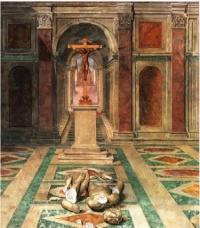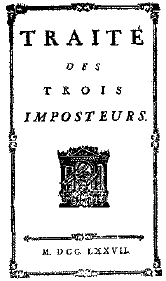Religion
From The Art and Popular Culture Encyclopedia
|
"But if cattle and horses and lions had hands [...]" --Xenophanes "I should like there to be perfect freedom to deride them all [all religions]; I should like men, gathered in no matter what temple to invoke the eternal who wears their image, to be seen as so many comics in a theater, at whose antics everyone may go to laugh." --Yet Another Effort, Frenchmen, If You Would Become Republicans (1795), Marquis de Sade "All known religious beliefs, whether simple or complex, present one common characteristic : they presuppose a classification of all the things, real and ideal, of which men think, into two classes or opposed groups, generally designated by two distinct terms which are translated well enough by the words profane and sacred (profane, sacré). This division of the world into two domains, the one containing all that is sacred, the other all that is profane, is the distinctive trait of religious thought. --The Elementary Forms of the Religious Life (1912), Émile Durkheim, tr. Joseph Ward Swain "The various modes of worship which prevailed in the Roman world were all considered by the people as equally true; by the philosophers as equally false; and by the magistrate as equally useful." --Edward Gibbon "I am aware that many people might be upset by my equating religion with fake news, but that’s exactly the point. When a thousand people believe some made-up story for one month – that’s fake news. When a billion people believe it for a thousand years – that’s a religion, and we are admonished not to call it ‘fake news’ in order not to hurt the feelings of the faithful (or incur their wrath)."--21 Lessons for the 21st Century (2018) by Yuval Harari "What happened to the Nihilist whose story is related by that profound thinker Dostoiewsky has quickly happened to the Positivists. Illumined one day by the light of reason he broke the images of divinities and saints that adorned the altar of a chapel, extinguished the candles, and, without losing a moment, replaced the destroyed objects by the works of atheistic philosophers such as Buchner and Moleschott, after which he piously relighted the candles. The object of his religious beliefs had been transformed, but can it be truthfully said that his religious sentiments had changed?"--The Crowd: A Study of the Popular Mind (1895) by Gustave Le Bon |

Illustration: The Invisible College of the Rose Cross Fraternity



Illustration: The Ecstatic Virgin Anna Katharina Emmerich by (1885) by Gabriel Cornelius von Max
|
Related e |
|
Featured: |
Religion is an organized collection of beliefs, cultural systems, and world views that relate humanity to an order of existence. Many religions have narratives, symbols, and sacred histories that are intended to explain the meaning of life and/or to explain the origin of life or the Universe. From their beliefs about the cosmos and human nature, people derive morality, ethics, religious laws or a preferred lifestyle. According to some estimates, there are roughly 4,200 religions in the world.
Many religions may have organized behaviors, clergy, a definition of what constitutes adherence or membership, holy places, and scriptures. The practice of a religion may also include rituals, sermons, commemoration or veneration of a deity, gods or goddesses, sacrifices, festivals, feasts, trance, initiations, funerary services, matrimonial services, meditation, prayer, music, art, dance, public service or other aspects of human culture. Religions may also contain mythology.
The word religion is sometimes used interchangeably with faith, belief system or sometimes set of duties; however, in the words of Émile Durkheim, religion differs from private belief in that it is "something eminently social". A global 2012 poll reports that 59% of the world's population is religious, and 36% are not religious, including 13% who are atheists, with a 9 percent decrease in religious belief from 2005. Some people follow multiple religions or multiple religious principles at the same time, regardless of whether or not the religious principles they follow traditionally allow for syncretism.
Contents |
Theories of religion
Theories of religion can be split up into substantive theories (focusing on what religion is) and functional or reductionist theories (focusing on what it does). Influential substantive theories have been proposed by Tylor and Frazer (focusing on the explanatory value of religion for its adherents), by the theologian Rudolf Otto (focusing on the importance of religious experience, more specifically experiences that are both fascinating and terrifying), Mircea Eliade (focusing on the longing for otherworldly perfection, the quest for meaning, and the search for patterns in mythology in various religions).
Influential functional theories have been proposed by Karl Marx (focusing on the economic background), Sigmund Freud (focusing on neurosis as a psychological origin of religious beliefs), and Émile Durkheim (focusing on the social function of religions).
Max Weber did not so much propose a general theory of religion as he focused on the interaction between society and religion. He also introduced a number of key concepts to the sociology of religion.
In contrast to earlier theorists, the anthropologists E. E. Evans-Pritchard and Clifford Geertz performed detailed ethnographical studies of "primitive" cultures, and came to the conclusion that earlier theories had been one-sided at best. Geertz denied that it would ever be possible to propose a general theory of religion.
Religion and science
The relationship between religion and science has been a focus of the demarcation problem. Statements about the world made by science and religion sometimes rely on different methodologies. Religion, it is often argued, relies on revelation and faith. The methods of science are elaborate. Some scholars say the two are separate, as in John William Draper's conflict thesis and Stephen Jay Gould's non-overlapping magisteria, while others (Thomas Berry, Brian Swimme, Ken Wilber, et al.) propose an interconnection.
Irreligion
Irreligion, irreligiousness, or nonreligion is an umbrella term which, depending on context, may be understood as referring to atheism, agnosticism, deism, skepticism, freethought, secular humanism, general secularism, or heresy.
Irreligion has at least three related yet distinct meanings:
- absence of religion (either due to not having information about religion or to not believing in it)
- hostility to religion
- behaving in such a way that fails to live up to one's religious tenets
Although people classified as irreligious might not follow any religion, not all are necessarily without belief in the supernatural or in deities; such a person may be a non-religious or non-practicing theist. In particular, those who associate organized religion with negative qualities, but still hold spiritual beliefs, might describe themselves as irreligious.
History of religion
The earliest evidence of religious ideas dates back several hundred thousand years to the Middle and Lower Paleolithic periods. Archeologists refer to apparent intentional burials of early homo sapiens from as early as 300,000 years ago as evidence of religious ideas. Other evidence of religious ideas include symbolic artifacts from Middle Stone Age sites in Africa. However, the interpretation of early paleolithic artifacts, with regard to how they relate to religious ideas, remains controversial. Archeological evidence from more recent periods is less controversial. A number of artifacts from the Upper Paleolithic (50,000-13,000) are generally interpreted by scientists as representing religious ideas. Examples of Upper Paleolithic remains associated with religious beliefs include the lion man, the Venus figurines, cave paintings from Chauvet Cave and the elaborate ritual burial from Sungir.
Religious groups
The list of still-active religious movements given here is an attempt to summarize the most important regional and philosophical influences on local communities, but it is by no means a complete description of every religious community, nor does it explain the most important elements of individual religiousness.
The five largest religious groups by world population, estimated to account for 5 billion people, are Christianity, Islam, Buddhism, Hinduism (with the relative numbers for Buddhism and Hinduism dependent on the extent of syncretism) and Chinese folk religion.
| Five largest religions | Adherents in 2000 | % of world population | Demographics |
|---|---|---|---|
| Christianity | 2.0 billion | 33% | Christianity by country |
| Islam | 1.2 billion | 19.6% | Islam by country |
| Hinduism | 811 million | 13.4% | Hinduism by country |
| Chinese folk religion | 385 million | 6.4% | Chinese folk religion |
| Buddhism | 360 million | 5.9% | Buddhism by country |
Religious studies
Religious studies is the scientific study of religion. It describes, compares, interprets, and explains religion, emphasizing empirical, historically based, and cross-cultural perspectives.
While theology attempts to understand the transcendent or supernatural according to traditional religious accounts, religious studies takes a more scientific and objective approach, independent of any particular religious viewpoint. Religious studies thus draws upon multiple academic disciplines and methodologies including anthropology, sociology, psychology, philosophy, and history of religion.
Religious studies originated in 19th-century Europe, when scholarly and historical analysis of the Bible had flourished, as Hindu and Buddhist sacred texts were first being translated into European languages. Early influential scholars included Friedrich Max Müller in England and Cornelis Petrus Tiele in the Netherlands. Today, religious studies is an academic discipline practiced by scholars worldwide. In its early years, it was known as "comparative religion" or the science of religion and, in the United States, there are those who today also know the field as the "History of religion" (associated with methodological traditions traced to the University of Chicago in general, and in particular Mircea Eliade, from the late 1950s through to the late 1980s).
See also
- Ancestor worship
- Cargo cult
- Philosophy of religion
- Sociology of religion
- Enclosed religious orders
- Irreligion
- Religious violence
- Faith
- Belief
- History of religions
- List of religious texts
- Pascal's wager
- Religious art
- Religious conversion
- Religions of hardship and religions of plenty
- Religious satire
- Theocracy
- Theogony
- Unbelieving



